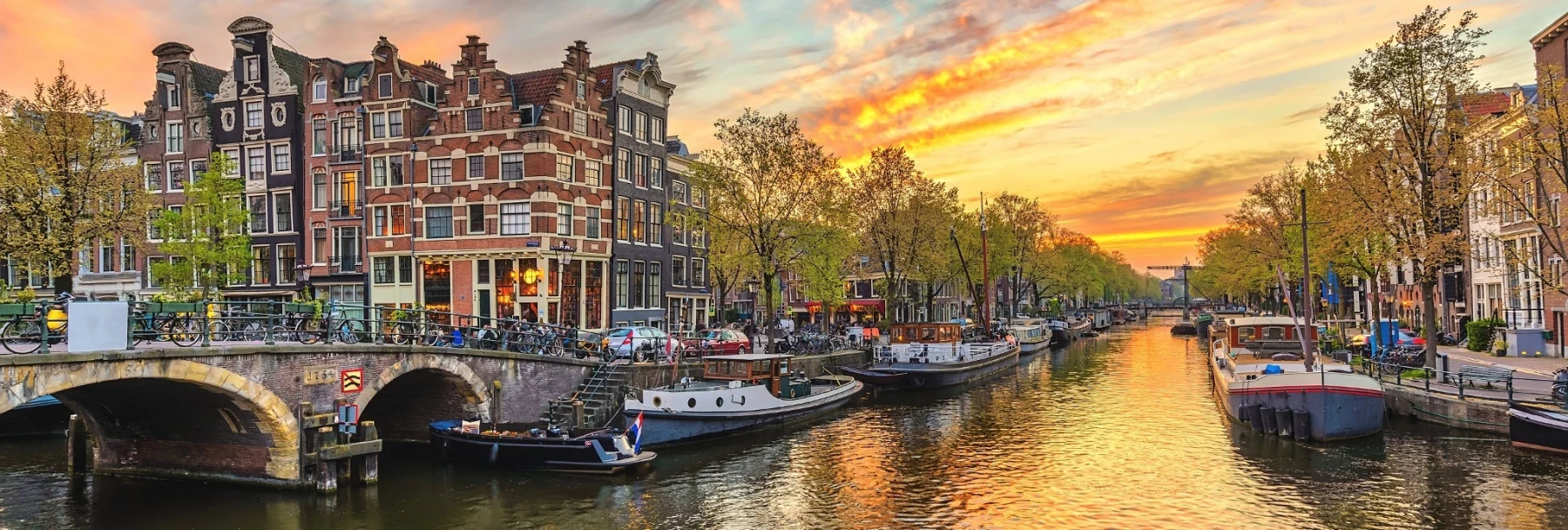The 12 essential things to do in Amsterdam
Last update : 26/05/2024 15:39Summary
- To visit
-
- 1 - Canal cruise
- 2 - Visit to the Rijksmuseum
- 3 - Van Gogh Museum
- 4 - Walk in the Red Light District
- 5 - Coffee shops
- 6 - Visit to the Anne Frank House
- 7 - Vondelpark
- 8 - Shopping in Jordaan
- 9 - Visit the Johan Cruijff ArenA
- 10 - See the windmills of Zaanse Schans
- 11 - Day trip to Keukenhof
- 12 - Excursion to Giethoorn
- Amsterdam - Where to Stay?
- Amsterdam - How to get around?
- Amsterdam - Best period
Amsterdam, the capital of the Netherlands, is a fascinating and dynamic city that seamlessly blends its rich historical heritage with vibrant modernity. Here's a description of Amsterdam at various levels:
-
Canal Belt: The heart of Amsterdam is adorned with a semi-circular canvas of canals, recognized as a UNESCO World Heritage site. The canals, lined with narrow and elegant facades of houses, create a picturesque and romantic atmosphere. Strolls along these canals offer captivating views of historical architecture and iconic bridges.
-
Art Museums: Amsterdam is home to some of the world's most renowned art museums. The Van Gogh Museum showcases an impressive collection of works by the famous artist, while the Rijksmuseum exhibits artistic and historical treasures, including works by Rembrandt and Vermeer.
-
Anne Frank House: A poignant witness to history, the Anne Frank House is where Anne Frank and her family hid during World War II. The visit provides a moving perspective on this dark period of history.
-
Eclectic Nightlife: Amsterdam is famous for its lively and diverse nightlife. From traditional cafes to trendy bars and electro music clubs, the city offers a myriad of options for those looking to enjoy the night.
-
Cycling and Active Lifestyle: With its extensive network of bike lanes, Amsterdam is undeniably a biking city. Bicycles are the preferred mode of transportation for locals, adding a unique dimension to urban life.
-
Tolerance and Diversity: The city is also recognized for its open-minded and tolerant spirit. Amsterdam has been ahead on many social issues, including the legalization of certain soft substances and early recognition of LGBTQ+ rights.
-
Cafés and Markets: Outdoor cafes along the canals provide ideal spots to relax and observe local life. Markets such as the floating flower market, Albert Cuypmarkt, and the Waterlooplein flea market add a lively touch to daily life.
-
Festivals and Events: Amsterdam hosts a variety of festivals throughout the year, from cultural celebrations to artistic and musical events.
Amsterdam is a city where history, culture, creativity, and modernity converge, creating a captivating destination for travelers from around the world.
1 - Canal cruise

A canal cruise in Amsterdam is a must-have experience for any visitor. Whether during the day to admire iconic architecture and historical sites or in the evening to enjoy the city's sparkling lights, here's what you can expect from a canal cruise in Amsterdam:
-
Panoramic Views: Cruises provide panoramic views of Amsterdam's picturesque canals, lined with elegant facades, iconic bridges, and historic landmarks.
-
Informative Commentary: Most cruises offer multilingual commentary, providing historical and cultural insights into the places you traverse.
-
Iconic Sites: You'll likely pass by iconic sites such as the Rijksmuseum, Anne Frank House, the Red Light District, and the Royal Palace.
-
Romantic Atmosphere: Evening cruises create a romantic atmosphere with the sparkling lights of buildings reflecting in the water.
-
Relaxation and Comfort: Cruise boats are comfortable, typically offering indoor and outdoor seating. Some even provide snacks and drinks onboard.
-
Themed Options: There are themed cruises, including cheese-tasting cruises, romantic dinner cruises, or brunch cruises, adding a special touch to your experience.
-
Flexibility of Timing: With multiple departures throughout the day, you can choose a schedule that best suits your plans.
Whether you're interested in history, romance, or just a leisurely way to explore the city, a canal cruise in Amsterdam offers a unique perspective on this captivating city.
 Our tips for getting the most out of your experience.
Our tips for getting the most out of your experience.
If you're planning to take a canal cruise in Amsterdam, here are some tips to make your experience even more enjoyable:
-
Book in Advance: Canal cruises in Amsterdam can be popular, especially during peak tourist seasons. It's advisable to book in advance to secure your spot, especially if you have a specific departure time in mind.
-
Choose the Right Time of Day: Daytime cruises offer detailed views of the architecture, while evening cruises create a romantic atmosphere with the city lights. Choose the time that best suits your preferences.
-
Opt for a Themed Cruise: Many companies offer themed cruises, such as cheese-tasting cruises, brunch cruises, or romantic dinner cruises. Choose an option that aligns with your interests for a unique experience.
-
Prepare for Weather: Amsterdam can have unpredictable weather, so check the forecast before your cruise. If you're traveling in the fall or winter, make sure to dress warmly.
-
Arrive Early: Arrive at the pier a bit early to avoid last-minute stress. This also gives you time to take photos and enjoy the surroundings before departure.
-
Choose an Outdoor Seat: If weather permits, opt for an outdoor seat on the boat. It's a great way to enjoy the scenery and take photos without having to shoot through glass.
-
Listen to Commentary: Canal cruises typically provide commentary in multiple languages. Listen attentively to learn more about the history and points of interest along the route.
-
Respect Other Passengers: Canals can be narrow, and space on the boat may be limited. Be courteous to fellow passengers to ensure a pleasant experience for everyone.
By following these tips, you'll enhance your enjoyment during your canal cruise in Amsterdam. Enjoy this unique and picturesque experience!
2 - Visit to the Rijksmuseum
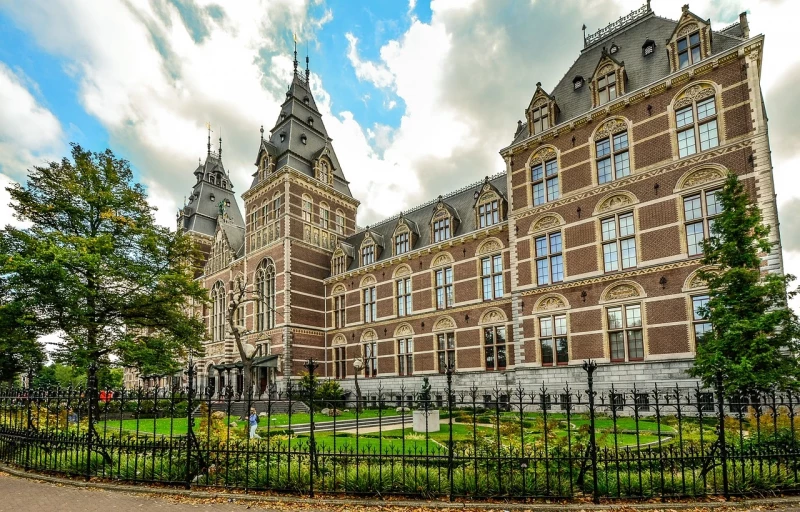
The Rijksmuseum is a Dutch national museum located in Amsterdam, Netherlands. It is dedicated to arts and history and is one of the most famous and visited museums in the country. Here are some key points about the Rijksmuseum:
-
History: The Rijksmuseum was founded in The Hague in 1800 and moved to Amsterdam in 1808. The current building, designed by architect Pierre Cuypers, opened its doors in 1885.
-
Collection: The museum boasts an extensive collection of Dutch art and history, spanning from the Middle Ages to the contemporary period. The collection includes paintings by renowned Dutch artists such as Rembrandt, Vermeer, and Frans Hals. The most famous painting in the collection is Rembrandt's "The Night Watch."
-
The Night Watch: Rembrandt's masterpiece, "The Night Watch" (1642), is one of the most iconic paintings in the museum. It is displayed in a specially designed gallery known as the "Gallery of Honor."
-
Other Highlights: Apart from "The Night Watch," the Rijksmuseum houses an impressive array of artworks, including Vermeer's "The Milkmaid," Jan Steen's "The Merry Family," and many other notable pieces from the Dutch Golden Age.
-
Decorative Arts and History: The museum also features a wide range of decorative arts, historical artifacts, and objects that provide insights into Dutch culture and history.
-
Library and Research Center: The Rijksmuseum has a library and research center that houses a vast collection of books, documents, and archives related to art and history.
-
Renovation: The Rijksmuseum underwent an extensive renovation that lasted for almost ten years and was completed in 2013. The renovation aimed to modernize the facilities while preserving the historic character of the building.
-
Gardens: The museum is surrounded by beautiful gardens, providing a pleasant outdoor space for visitors to relax.
The Rijksmuseum is a cultural treasure trove and a must-visit destination for art enthusiasts and history lovers visiting Amsterdam.
 Our tips for getting the most out of your experience.
Our tips for getting the most out of your experience.
Visiting the Rijksmuseum in Amsterdam can be a rewarding experience. Here are some tips to make the most of your visit:
-
Plan Your Visit: Check the museum's website for opening hours, admission prices, and information on temporary exhibitions. Plan your visit accordingly.
-
Buy Tickets in Advance: Skip the lines by purchasing your tickets online. This will allow you to enter more quickly and save time on-site.
-
Explore the Collection Online Beforehand: Take a look at the museum's online collection to get an idea of the artworks you want to see in person. This will help you optimize your time during the visit.
-
Visit Early Morning or Late Afternoon: The museum is often less crowded early in the morning or late in the afternoon. Try to plan your visit during these times to avoid crowds.
-
Focus on Highlights: The Rijksmuseum has an extensive collection, but if you have limited time, focus on highlights such as Rembrandt's "The Night Watch" and other major works.
-
Take a Guided Tour: If you want to learn more about the displayed artworks, consider joining a guided tour. Guides can provide insightful and in-depth information about the art.
-
Start with the Gallery of Honor: The Gallery of Honor houses masterpieces by Dutch masters like Rembrandt and Vermeer. Begin your visit here to see some of the museum's most famous works.
-
Enjoy Outdoor Spaces: The gardens surrounding the Rijksmuseum provide a pleasant place to relax. Take the time to stroll through them and enjoy the peaceful atmosphere.
-
Visit on Weekdays: If possible, plan your visit on weekdays to avoid larger crowds typically seen on weekends.
-
Be Respectful: During your visit, be respectful of the artworks and fellow visitors. Avoid touching the artworks and make sure to follow the museum's rules.
By following these tips, you should be able to fully enjoy your visit to the Rijksmuseum and explore the rich artistic history of the Netherlands.
3 - Van Gogh Museum
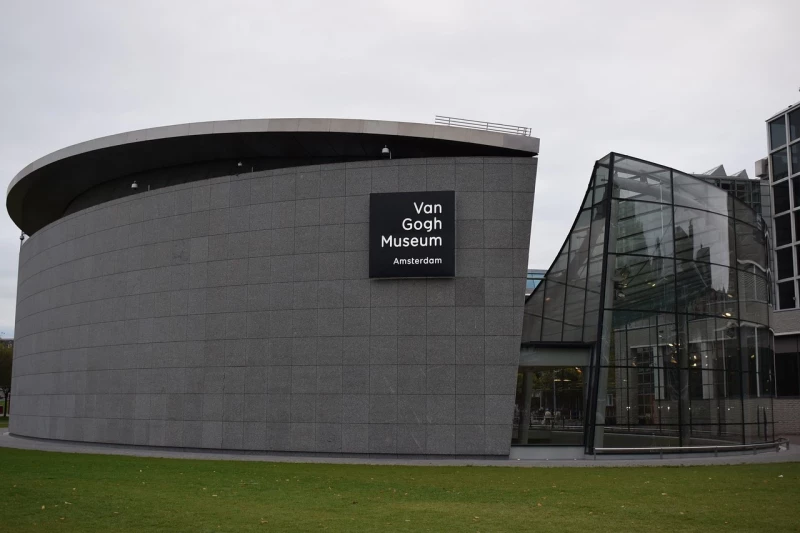
The Van Gogh Museum is another iconic museum located in Amsterdam, Netherlands. Here are some key details about the Van Gogh Museum:
-
History: The Van Gogh Museum is dedicated to the life and works of the Dutch painter Vincent van Gogh and his contemporaries. It opened its doors to the public in 1973.
-
Collection: The museum houses the largest collection of Van Gogh's paintings and drawings in the world. It features over 200 paintings, 500 drawings, and 700 letters by Vincent van Gogh.
-
Masterpieces: Some of the most famous paintings by Van Gogh in the museum's collection include "The Bedroom," "Sunflowers," "Irises," and "Almond Blossom."
-
Exhibitions: In addition to Van Gogh's works, the museum also hosts temporary exhibitions that explore various aspects of his life, art, and the art world of his time.
-
Documentation Center: The Van Gogh Museum has a documentation center that includes the artist's letters, sketches, and other archival material. This provides insight into the artist's creative process and personal life.
-
Building Design: The museum's building was designed by architect Gerrit Rietveld and opened in 1973. It underwent a renovation in the late 20th century, and the new exhibition wing was added in 1999.
-
Museum Shop and Café: The museum has a shop where you can purchase reproductions of Van Gogh's artwork, books, and other art-related items. There's also a café where you can take a break and enjoy refreshments.
-
Visitor Tips: Like the Rijksmuseum, it's advisable to purchase tickets in advance to avoid long queues. Consider getting an audio guide to enhance your understanding of the artworks.
-
Educational Programs: The museum offers educational programs for various age groups, including workshops and guided tours.
-
Interactive Elements: The museum often incorporates interactive elements and multimedia displays to engage visitors and provide a deeper understanding of Van Gogh's art and life.
Visiting the Van Gogh Museum is a must for art enthusiasts, and it offers a unique opportunity to immerse yourself in the world of one of the most influential painters in art history.
 Our tips for getting the most out of your experience.
Our tips for getting the most out of your experience.
Visiting the Van Gogh Museum in Amsterdam can be a memorable experience. Here are some tips to make the most of your visit:
-
Buy Tickets Online: Skip the lines by purchasing your tickets online in advance. This will allow you to enter the museum more quickly.
-
Plan Your Visit: Check the museum's website for opening hours and information on temporary exhibitions. Plan your visit accordingly.
-
Visit Early Morning or Late Afternoon: Consider visiting during the early morning or late afternoon to avoid peak crowds. This can provide a more serene experience with the artworks.
-
Focus on Major Works: The Van Gogh Museum has an extensive collection. If time is limited, focus on major works like "The Bedroom," "Sunflowers," and "Irises."
-
Use an Audio Guide: Audio guides are available in multiple languages and provide detailed information on the artworks, as well as insights into Van Gogh's life.
-
Explore Van Gogh's Personal History: The museum often offers exhibitions and information about Van Gogh's personal life. Take the time to explore these aspects to gain a deeper understanding of the artist and his work.
-
Join a Guided Tour: Guided tours can offer additional perspectives and enhance your understanding of the displayed artworks.
-
Take Advantage of Educational Facilities: The museum often provides educational activities for children and families. If you're traveling with kids, check out these programs.
-
Photograph Responsibly: Respect the museum's photography rules. Some exhibits may restrict photography, so make sure to check the guidelines.
-
Visit the Café and Museum Shop: Take a break at the museum's café for refreshments, and explore the museum shop for unique artistic souvenirs.
-
Mind Your Timing: The Van Gogh Museum can be particularly busy at certain times. If possible, visit during weekdays or less touristy months to avoid large crowds.
By following these tips, you should be able to fully enjoy your visit to the Van Gogh Museum and appreciate the rich collection of artworks by one of the greatest artists in art history.
4 - Walk in the Red Light District
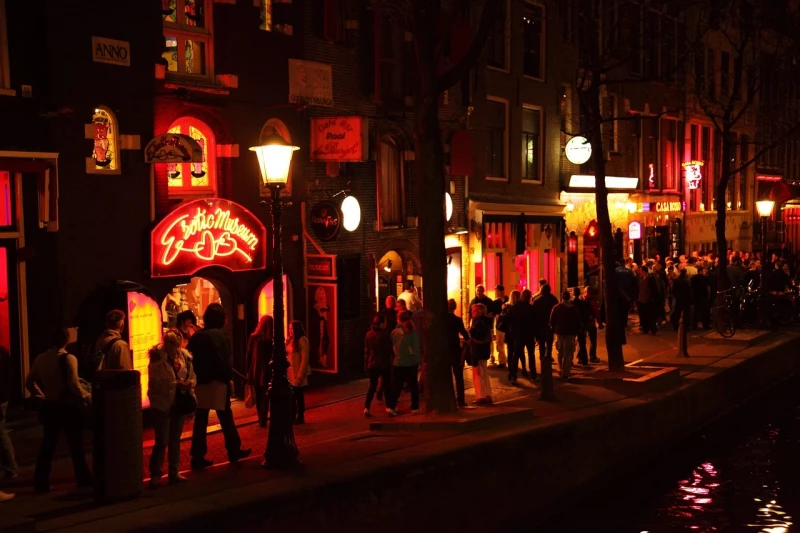
The Red Light District of Amsterdam, also known as De Wallen, is a famous district in the city center of Amsterdam, Netherlands. Here are some key points about the Red Light District:
-
Legalized Prostitution: The Red Light District is known for its windows where sex workers display their services. Prostitution is legal in the Netherlands, and the Red Light District is one of the areas where it is practiced openly.
-
Illuminated Windows: Sex workers present their services behind illuminated windows along the narrow streets of the district. The characteristic red lights indicate that sex workers are available.
-
Cafés and Bars: In addition to prostitution, the Red Light District is home to numerous cafés, bars, and restaurants. It's a lively area with diverse nightlife.
-
Historic Architecture: De Wallen is one of Amsterdam's oldest neighborhoods, with preserved historic architecture. You'll find traditional Dutch buildings, picturesque canals, and cobblestone streets.
-
Museums: The district also hosts interesting museums, including the Museum of Prostitution (Red Light Secrets), which provides insight into the history of prostitution in Amsterdam.
-
Tourism: The Red Light District is one of the most popular tourist attractions in Amsterdam. Visitors can explore the area on foot, but it's crucial to respect the privacy of sex workers and adhere to established rules.
-
Tolerance Policy: Dutch authorities have adopted a policy of tolerance toward prostitution and the Red Light District, while implementing regulations to protect sex workers and ensure a safe environment.
-
Safety: While the Red Light District is generally safe for visitors, it's advisable to remain vigilant, especially at night, and to show respect for those who work and live in the area.
-
Tolerance Policy: Dutch authorities have adopted a policy of tolerance toward prostitution and the Red Light District, while implementing regulations to protect sex workers and ensure a safe environment.
-
Special Events: The Red Light District can host special events and festivals throughout the year. It's recommended to check for local events before planning a visit.
The Red Light District is a unique blend of culture, history, nightlife, and controversy, attracting visitors from around the world. If you decide to visit, make sure to respect the environment and the people who live and work there.
 Our tips for getting the most out of your experience.
Our tips for getting the most out of your experience.
Walking through Amsterdam's Red Light District can be a unique experience. Here are some tips to enjoy this walk in a respectful and enjoyable manner:
-
Respect Privacy: Remember that the Red Light District is primarily a workplace for sex workers. Respect their privacy by avoiding taking photos or staring intrusively.
-
Be Respectful: Refrain from making derogatory comments or disrupting the work of people in the windows. Adopt a respectful attitude towards sex workers and residents of the district.
-
Avoid Taking Photos: While the Red Light District is a tourist attraction, it is often recommended not to take photos, especially of sex workers. Respect the rules in place to protect their privacy.
-
Follow Local Rules: The Red Light District has its own rules and regulations. Follow them to ensure a trouble-free visit.
-
Be Aware of Your Surroundings: While the Red Light District is safe for visitors, be aware of your surroundings, especially at night. Avoid dark alleys and stick to main streets.
-
Explore the Surroundings: In addition to the illuminated windows, explore the cafes, bars, and restaurants in the area. Discover the historic architecture and the unique atmosphere of De Wallen.
-
Learn the History: The Red Light District has a rich history. If possible, learn about its past before visiting to better understand its evolution and cultural significance.
-
Be Discreet: Keep in mind that some people may be sensitive to the presence of tourists. Be discreet in your exploration of the district.
-
Take a Guided Tour: For a more in-depth perspective, consider joining a guided tour. Experienced guides can provide contextual information and answer your questions.
-
Relax in Cafés: Take the time to relax in one of the district's cafes. This can be an excellent opportunity to soak in the atmosphere while respecting the space of residents and workers.
Walking through the Red Light District can be a cultural and intriguing experience, but it's essential to do so respectfully towards the people who live and work there.
5 - Coffee shops

In Amsterdam, coffee shops are unique establishments where it is legal to purchase and consume cannabis within a regulated framework. These should not be confused with regular cafés. Here are some key points to know about Amsterdam's coffee shops:
-
Cannabis Sales: Amsterdam's coffee shops are authorized to sell cannabis to customers who are at least 18 years old. These establishments are often known for their variety of cannabis products, including pre-rolled joints and edibles.
-
On-Site Consumption: In most coffee shops, customers can consume cannabis on-site, usually in a relaxed atmosphere. Some establishments also have designated smoking areas.
-
Quantity Limits: Customers are typically limited to purchasing a certain amount of cannabis per visit. Specific rules vary between establishments and are regulated by the municipality.
-
Mandatory Identification: To enter a coffee shop and purchase cannabis, a form of identification proving that you are at least 18 years old is usually required.
-
Alcohol Sales Prohibited: Most coffee shops do not sell alcohol. The consumption of alcohol and cannabis in the same establishment is generally prohibited.
-
Respect for Rules: It is important to respect the specific rules of each coffee shop and adhere to applicable laws. Establishments are regularly inspected to ensure compliance.
-
Variety of Strains: Coffee shops often offer a variety of cannabis strains, each with its own characteristics in terms of taste, aroma, and effects.
-
Cannabis Education: Some coffee shops strive to provide educational information about cannabis, including advice on responsible consumption.
It's crucial to remember that while cannabis consumption is legal in Amsterdam's coffee shops, it is still subject to strict rules. Visitors should be informed and respectful of local laws and the policies of each establishment.
 Our tips for getting the most out of your experience.
Our tips for getting the most out of your experience.
Visiting coffee shops in Amsterdam can be a unique experience. Here are some tips to enjoy this experience responsibly and informed:
-
Research Local Laws: Before visiting a coffee shop, familiarize yourself with local laws regarding cannabis consumption. Respect the specific rules of each establishment.
-
Bring ID: To enter a coffee shop and purchase cannabis, a valid ID proving you are at least 18 years old is typically required.
-
Know Your Limits: Coffee shops often have limits on the amount of cannabis you can purchase. Be aware of these limits and consume responsibly.
-
Be Respectful: Respect other customers, coffee shop staff, and established rules. Avoid smoking near non-smokers.
-
Choose Carefully: Coffee shops offer a variety of cannabis strains. If you have questions, don't hesitate to ask the staff for recommendations.
-
Avoid Combining with Alcohol: Consuming cannabis and alcohol in the same establishment is often prohibited. Adhere to this rule to avoid issues.
-
Consumption Advice: If you are not familiar with cannabis consumption, seek advice from coffee shop staff. They can provide guidance on the effects and potency of different strains.
-
Respect Others' Space: Coffee shops can be busy places. Respect the privacy of other customers and avoid staring or taking intrusive photographs.
-
Cannabis Education: Some coffee shops provide educational information about cannabis. Take the opportunity to learn more about different products and their effects.
-
Avoid Overconsumption: Cannabis can affect individuals differently. Start slowly and avoid overconsumption to prevent unpleasant experiences.
-
Choose the Atmosphere You Prefer: Coffee shops have diverse atmospheres. Some are lively, while others offer a more tranquil setting. Choose one that suits your preference.
By following these tips, you should be able to enjoy your experience in Amsterdam's coffee shops responsibly and respectfully.
6 - Visit to the Anne Frank House
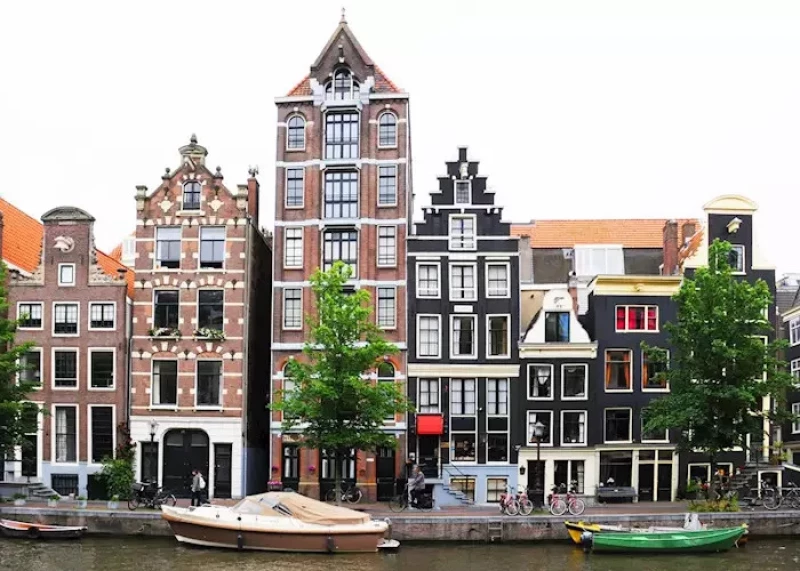
The Anne Frank House in Amsterdam is a museum dedicated to the story of Anne Frank, a Jewish girl who wrote a diary during World War II. Here are some key points about the Anne Frank House:
-
History: The Anne Frank House is located in the center of Amsterdam and is the house where Anne Frank and her family hid during the Nazi occupation of the Netherlands in World War II.
-
Anne Frank's Diary: Anne Frank wrote her diary, "The Diary of Anne Frank," during the time her family was in hiding. The diary was discovered and published after the war, becoming one of the most moving accounts of that era.
-
Museum Visit: The museum is set up in the secret annex where Anne Frank and her family lived in hiding. Visitors can see the original rooms, historical documents, and exhibitions related to the Holocaust.
-
Collections: The museum displays original objects, photographs, and documents related to Anne Frank's life and the persecution of Jews during the war.
-
Historical Testimony: The Anne Frank House serves as a poignant testimony to the horrors of persecution during the Holocaust and emphasizes the importance of combating discrimination and intolerance.
-
Visitation: Due to its historical significance, the Anne Frank House attracts a large number of visitors from around the world. It is recommended to book tickets in advance to avoid long queues.
-
Education: The museum offers educational programs for young people and school groups to raise awareness about themes of tolerance and respect.
-
Events: The museum occasionally hosts special events, temporary exhibitions, and conferences to deepen understanding of this dark period in history.
The Anne Frank House is a moving place that provides visitors with an opportunity to reflect on the past and remember the atrocities of the Holocaust. It is a must-visit historical site for those traveling to Amsterdam.
 Our tips for getting the most out of your experience.
Our tips for getting the most out of your experience.
Visiting the Anne Frank House in Amsterdam is a moving and educational experience. Here are some tips to make the most of your visit:
-
Book Tickets in Advance: Due to high demand, it is strongly recommended to book your tickets online in advance. This will help you avoid long queues at the entrance.
-
Prepare for Crowds: Expect the Anne Frank House to be frequently crowded. To avoid the crowds, consider visiting early in the morning or late in the afternoon.
-
Use the Audio Guide: The audio guide available at the entrance provides detailed information about each room in the house, along with excerpts from Anne Frank's diary. This will significantly enhance your experience.
-
Respect the Sacred Nature of the Place: The Anne Frank House is a place charged with emotion. Respect the memory of Anne Frank and the millions who suffered during World War II by adopting a respectful demeanor.
-
Take Your Time: The visit can be emotionally intense. Take your time to absorb the history and impact of the place. Some rooms are preserved in their original state, adding to the authenticity of the experience.
-
Be Mindful of the Physical Layout: The historic house consists of narrow staircases and confined spaces. Be prepared for a visit that may involve going up and down stairs.
-
Participate in Educational Programs: If you are visiting with children or students, check out the educational programs offered by the museum. This can provide a deeper understanding of Anne Frank's history.
-
Explore the Adjacent Museum: The museum adjacent to the Anne Frank House features temporary exhibitions and delves into certain aspects of the history. Take the time to visit it if possible.
-
Photograph Respectfully: Some parts of the museum have restrictions on photography to preserve the integrity of the space. Respect these rules and ask the staff if you have any doubts.
-
Prepare Emotionally: The visit can be emotional. Be prepared to be moved by Anne Frank's story and to reflect on the lessons that can be drawn from this dark period in history.
By following these tips, you should have a rewarding visit to the Anne Frank House and gain a deeper understanding of the impact of the Holocaust on Anne Frank and her family's lives.
7 - Vondelpark
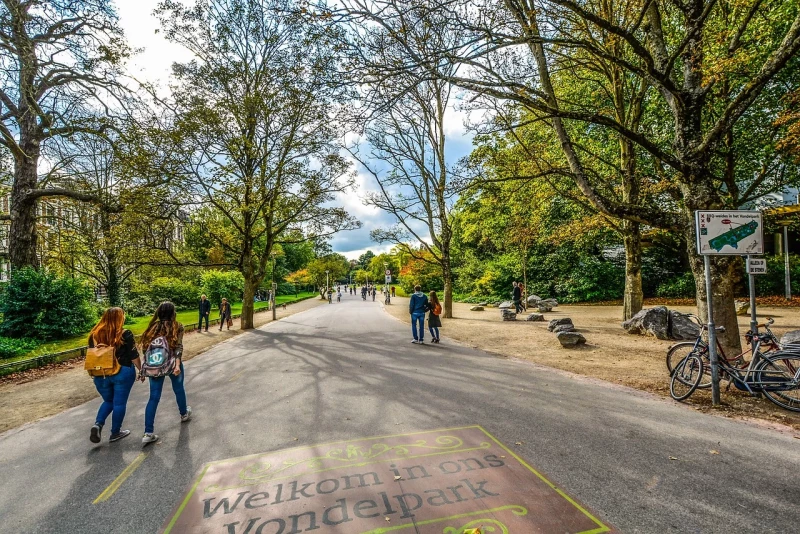
Vondelpark, a renowned public park in Amsterdam, takes its name from the Dutch playwright Joost van den Vondel. Established in 1865, the park has undergone expansions and renovations over the years, evolving into one of the city's most beloved green spaces. Nestled in the southwest of the city center, Vondelpark is surrounded by residential neighborhoods and is easily accessible on foot or by bike from various parts of the city.
This picturesque park boasts a range of facilities, including playgrounds, ponds, cycling and walking paths, sculptures, sports fields, cafes, and landscaped gardens. It serves as an ideal retreat for locals and visitors alike to unwind amidst nature.
Vondelpark also comes alive with a variety of cultural events, open-air concerts, artistic performances, and festivals. Whether for jogging, cycling, or simply relaxing, many people frequent the park to escape the hustle and bustle of the city.
Due to its proximity to the city center, Vondelpark is easily reachable by public transportation. It stands as a green oasis in the heart of Amsterdam, providing a peaceful haven for those seeking nature and outdoor leisure.
 Our tips for getting the most out of your experience.
Our tips for getting the most out of your experience.
If you're planning to visit Vondelpark in Amsterdam, here are some tips to enhance your experience:
-
Visiting Hours: The park is open year-round, and each season offers a different experience. Summer months might be livelier with outdoor events, while autumn showcases beautiful foliage. Check the park's schedule for any special events during your visit.
-
Activities: Set aside time to explore the park's various features, including playgrounds, sculptures, and ponds. Renting a bike is a great way to traverse the specially designed cycling paths.
-
Picnic: Consider bringing a picnic. Vondelpark is an ideal spot to sit on the grass and enjoy an outdoor day. You can purchase snacks at the park's cafes or bring your own provisions.
-
Events: Check the event calendar to see if there are concerts, festivals, or other special activities during your visit.
-
Photography: Don't forget your camera. The park offers numerous picturesque views, whether it's bridges over ponds, artistic sculptures, or simply natural landscapes.
-
Respect the Environment: Contribute to the cleanliness of the park by using the provided trash bins. Also, respect nature and fellow visitors by avoiding disturbance to wildlife and practicing courtesy.
-
Orientation: The park is quite expansive, so make sure to orient yourself to avoid getting lost. Maps of the park are usually available at the entrance.
-
Transportation: If you're not nearby, use public transportation or rent a bike to get to the park. It's a popular and convenient way to get around Amsterdam.
By following these tips, you'll be able to fully enjoy your visit to Vondelpark and appreciate this beautiful green space in the heart of Amsterdam.
8 - Shopping in Jordaan
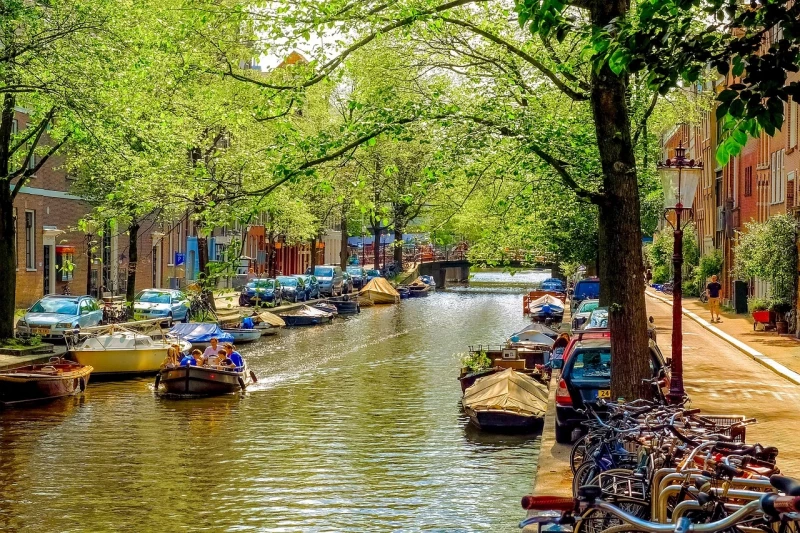
Shopping in the Jordaan district in Amsterdam offers a unique and diverse experience with its picturesque streets, original boutiques, and bohemian atmosphere. If you're interested in exploring the shopping scene in Jordaan, here are some places to check out:
-
The 9 Straatjes (The 9 Streets): This neighborhood, located near Jordaan, is famous for its nine picturesque streets filled with unique shops, art galleries, concept stores, and cafes. You'll find a wide variety of clothing, accessories, vintage items, and artistic creations.
-
Haarlemmerstraat and Haarlemmerdijk: These two streets, also nearby Jordaan, offer a diverse selection of shops, design boutiques, vintage fashion stores, bookshops, and cafes. It's an excellent area to discover one-of-a-kind items.
-
Noordermarkt: This market takes place on Mondays and Saturdays, offering a variety of products, including vintage clothing, accessories, jewelry, organic products, and more. It's a lively market that's worth exploring.
-
Brouwersgracht: Often considered one of the most beautiful streets in Amsterdam, Brouwersgracht features antique shops, art galleries, and small boutiques. It's also a delightful area for a canal-side stroll.
-
Westerstraat: This street is known for its flea market held on Mondays. You can find vintage clothing, retro furniture, decor items, and more.
-
Concept Stores: Jordaan is home to several concept stores offering a variety of products, from fashion to art and design objects. These stores often feature unique and trendy selections.
By exploring these places, you can discover a wide range of items, from vintage treasures to contemporary fashion, all while enjoying the charming atmosphere of Jordaan.
 Our tips for getting the most out of your experience.
Our tips for getting the most out of your experience.
If you're planning to go shopping in Jordaan, Amsterdam, here are some tips to enhance your experience:
-
Explore the 9 Straatjes: The 9 Streets (Les 9 Ruelles) is a must-visit area for shopping in Jordaan. Take the time to explore these picturesque streets filled with unique boutiques, concept stores, art galleries, and cafes. It's the perfect place to find one-of-a-kind items.
-
Local Markets: Jordaan is home to several markets, such as Noordermarkt. Check the market days to discover unique products, vintage clothing, accessories, and handmade crafts.
-
Stroll along Brouwersgracht: Often considered one of the most beautiful streets in Amsterdam, Brouwersgracht features antique shops, art galleries, and a charming canal-side ambiance. Take a leisurely stroll and uncover hidden treasures.
-
Visit Concept Stores: Jordaan has numerous concept stores offering a carefully curated selection of clothing, accessories, and home decor. These stores often feature unique and trendy items.
-
Explore Side Streets: Don't hesitate to venture into the smaller side streets of Jordaan. You might find less crowded but equally interesting shops.
-
Enjoy Local Cafes and Restaurants: Take a shopping break to enjoy a hot drink or a meal at one of the many cafes and restaurants in the area. It's also an opportunity to experience the local culinary scene.
-
Choose Weekdays if Possible: If you can, plan your visit on weekdays to avoid the crowds that can gather over the weekends.
-
Be Open to Discovery: Jordaan is known for its diversity. Be ready to discover artistic creations, unique vintage pieces, and design items that you might not find elsewhere.
By following these tips, you'll be better prepared to fully enjoy your shopping experience in Jordaan and uncover the treasures that this iconic Amsterdam neighborhood has to offer.
9 - Visit the Johan Cruijff ArenA
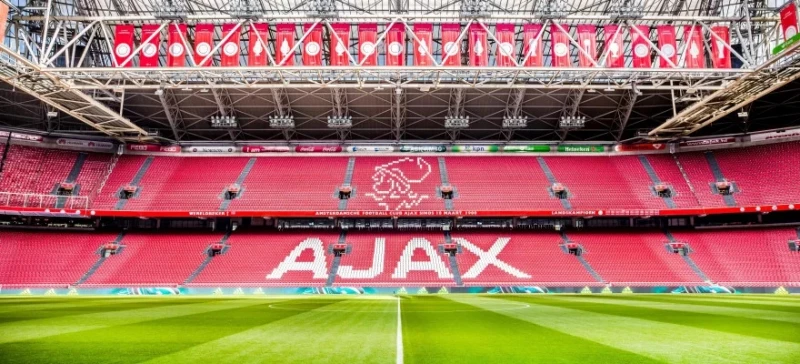
Visiting the Johan Cruijff ArenA, formerly known as the Amsterdam ArenA, is a great experience for football enthusiasts. Here are some useful tips if you plan to visit the Johan Cruijff ArenA:
-
Guided Tours: The best way to explore the stadium is by taking a guided tour. These tours take you behind the scenes, including the locker rooms, stands, and other areas typically reserved for players and staff.
-
Hours and Availability: Check the schedule for guided tours and make sure to book in advance, especially during peak times or on match days. Tour schedules may vary based on scheduled events at the stadium.
-
Discovering History: The Johan Cruijff ArenA has a rich history, hosting major sporting events, including FIFA World Cup matches. Take the opportunity to learn about the stadium's history and the Ajax football club during your visit.
-
Panoramic View: Make sure to climb up to the stands for a panoramic view of the stadium. It's an excellent opportunity to take memorable photos of the interior and the pitch.
-
Ajax Museum: If you're a football fan, don't miss the Ajax Museum inside the stadium. You'll find trophies, historic jerseys, and other items related to the club's history.
-
Official Store: The Johan Cruijff ArenA has an official store where you can purchase souvenirs, jerseys, and other items related to Ajax and the stadium.
-
Access and Transportation: Check transportation options to get to the Johan Cruijff ArenA. The stadium is well-connected by public transportation, including the metro.
Before planning your visit, make sure to check the latest information on tour schedules, availability, and any events that might impact the stadium tour. Take the opportunity to immerse yourself in the unique atmosphere of a venue steeped in football history.
10 - See the windmills of Zaanse Schans
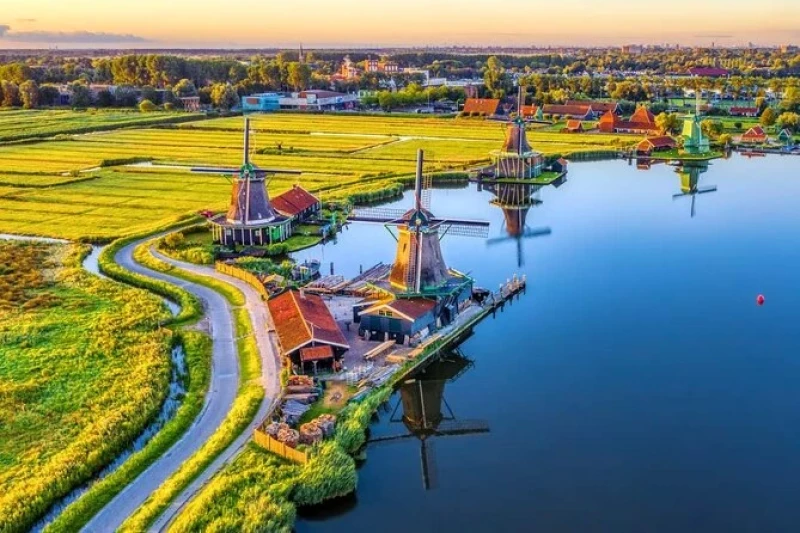
The windmills of Zaanse Schans are iconic attractions in the Netherlands. Zaanse Schans is a historic village near Amsterdam, known for its well-preserved windmills and traditional wooden houses. Here is some information about these windmills:
-
History: The windmills of Zaanse Schans are part of a collection that has been moved to the region over the centuries. They were used for various industrial activities such as oil and flour production and wood sawing.
-
Operation: Some of the windmills at Zaanse Schans are still operational. You can witness demonstrations to see how they were used in the past to generate power. Some windmills also offer guided tours to explain their history and operation.
-
Types of Windmills: The windmills at Zaanse Schans include various types, such as oil mills, flour mills, and sawmills. Each had a specific function related to the local industry.
-
Panoramic View: Climb to the top of a windmill to enjoy a panoramic view of the surrounding Dutch countryside. It's an excellent opportunity for taking photos and appreciating the picturesque landscape.
-
Activities at Zaanse Schans: In addition to the windmills, Zaanse Schans offers other attractions, including museums, craft workshops, traditional wooden houses, and shops selling local products.
-
Access: Zaanse Schans is easily accessible from Amsterdam. You can take a train to Zaandijk-Zaanse Schans station and then walk to the site. It's also possible to reach Zaanse Schans by boat from Amsterdam.
-
Opening Hours: The opening hours of the windmills may vary depending on the season. It's recommended to check the schedules before your visit.
Visiting the windmills of Zaanse Schans provides a fascinating glimpse into the industrial history of the Netherlands and offers a picturesque experience for history and culture enthusiasts.
 Our tips for getting the most out of your experience.
Our tips for getting the most out of your experience.
If you're planning to visit the windmills at Zaanse Schans, here are some tips to enhance your experience:
-
Timing: Try to plan your visit early in the morning or late in the afternoon to avoid crowds, especially if you're visiting during the peak tourist season.
-
Guided Tour: Opt for a guided tour to get detailed information about the history, operation, and unique features of the windmills. Guides can share interesting anecdotes and answer your questions.
-
Live Demonstrations: Make sure to visit windmills that offer live demonstrations of their operation. This will give you a better understanding of the engineering behind these iconic structures.
-
Climb to the Top: Climb to the top of a windmill to enjoy a panoramic view of the surrounding area. It's an excellent opportunity for picturesque photos.
-
Combined Tickets: If you plan to visit other attractions at Zaanse Schans, check if there are combined tickets offering discounts for multiple sites.
-
Check Opening Hours: Verify the opening hours of the windmills as they may vary depending on the season and holidays. Some windmills may also be closed for renovations or special events.
-
Transportation: Use public transportation to get to Zaanse Schans from Amsterdam. It's a convenient option, allowing you to fully focus on your visit.
-
Special Events: Check Zaanse Schans' event calendar. Sometimes, there are festivals, craft markets, or other special events that can enrich your experience.
-
Appropriate Attire: Dress appropriately based on the weather as visiting the windmills may involve walking outdoors.
-
Environmental Respect: Adhere to the guidelines and rules of the site to ensure the preservation of the windmills and their surroundings.
By following these tips, you'll be able to fully enjoy your visit to the windmills at Zaanse Schans and immerse yourself in Dutch heritage.
11 - Day trip to Keukenhof
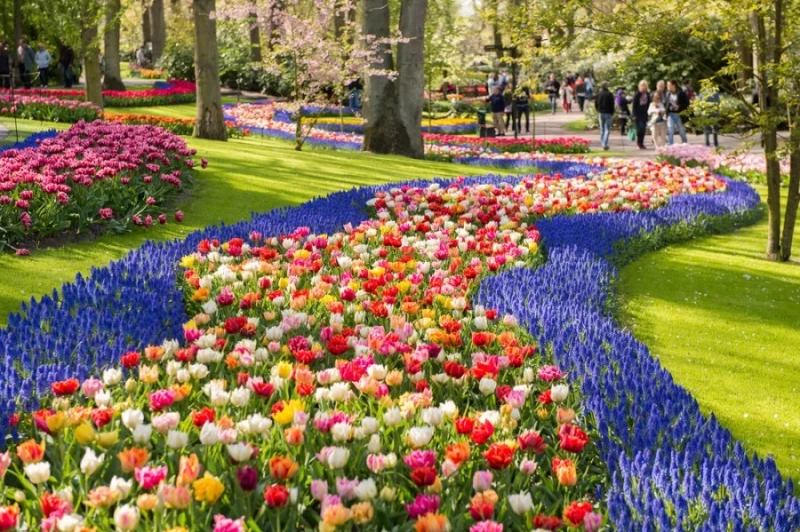
Keukenhof, also known as the "Gardens of Europe," is one of the largest flower gardens in the world. Located in Lisse, the Netherlands, Keukenhof is renowned for its extensive fields of tulips and other bulb flowers. Here is some useful information about Keukenhof:
-
Tulip Season: Keukenhof is open each year during the tulip season, typically from mid-March to mid-May. The exact period can vary depending on weather conditions.
-
Variety of Flowers: The park showcases an impressive variety of flowers, with millions of tulips in various colors, as well as daffodils, hyacinths, crocuses, and other spring flowers.
-
Garden Design: Keukenhof's gardens are artistically designed with beautiful floral patterns. Visitors can stroll through winding pathways, picturesque bridges, and pleasant resting areas.
-
Special Events: Keukenhof organizes various special events throughout the season, including floral exhibitions, flower parades, and other cultural activities.
-
Windmills: In addition to the flower fields, Keukenhof is home to traditional Dutch windmills, adding to the picturesque ambiance.
-
Photography: The park provides excellent opportunities for photography, especially with the flower fields as a backdrop and carefully arranged floral displays.
-
Children's Activities: Keukenhof offers special activities for children, including playgrounds, mazes, and floral treasure hunts.
-
Access: The park is accessible by car, bus from Amsterdam, or through organized tours. Parking is available on-site.
-
Shops and Restaurants: Keukenhof has souvenir shops and several restaurants where you can enjoy local dishes.
-
Purchase Bulbs: At the end of your visit, you have the opportunity to buy flower bulbs to plant in your own garden.
Keukenhof is a must-visit destination for flower and garden enthusiasts, providing a spectacular visual experience in spring. Make sure to check the exact opening dates before planning your visit.
 Our tips for getting the most out of your experience.
Our tips for getting the most out of your experience.
If you're planning a day trip to Keukenhof from Amsterdam, here are some tips to enhance your experience:
-
Transportation: Use public transportation to get to Keukenhof from Amsterdam. Direct buses are available from Amsterdam Central Station. Organized tours with transportation included are also a convenient option.
-
Combined Tickets: Some tours offer combined tickets that include transportation from Amsterdam and entry to Keukenhof. This can save you time and money.
-
Book in Advance: If opting for an organized tour, be sure to book in advance, especially during the peak tulip season. This ensures your spot and avoids last-minute hassles.
-
Departure Time: Choose an early morning departure time to maximize your time at Keukenhof and avoid crowds.
-
Prepare to Walk: Keukenhof is a large park with many trails to explore. Wear comfortable shoes and be prepared to walk to see all the points of interest.
-
Park Map: Upon arrival, grab a park map to orient yourself and plan your itinerary based on your preferences.
-
Morning Visit: If possible, plan your visit in the morning to enjoy the morning light, which can make the flower fields even more dazzling.
-
Pack Lunch: Bring a picnic or take advantage of the on-site restaurants and cafes for lunch. Picnic areas are also available if you prefer to bring your own meal.
-
Free Time: Allocate some free time to explore at your own pace and relax in the quieter areas of the park.
-
Souvenir Shops: Don't miss the souvenir shops at Keukenhof, where you can purchase local products, floral souvenirs, and flower bulbs to take home.
-
Weather Check: Check the weather forecast before your departure and dress accordingly, as the weather in the Netherlands can be changeable.
By following these tips, you'll be well-prepared to fully enjoy your day trip to Keukenhof from Amsterdam and marvel at the beautiful spring flower fields.
12 - Excursion to Giethoorn
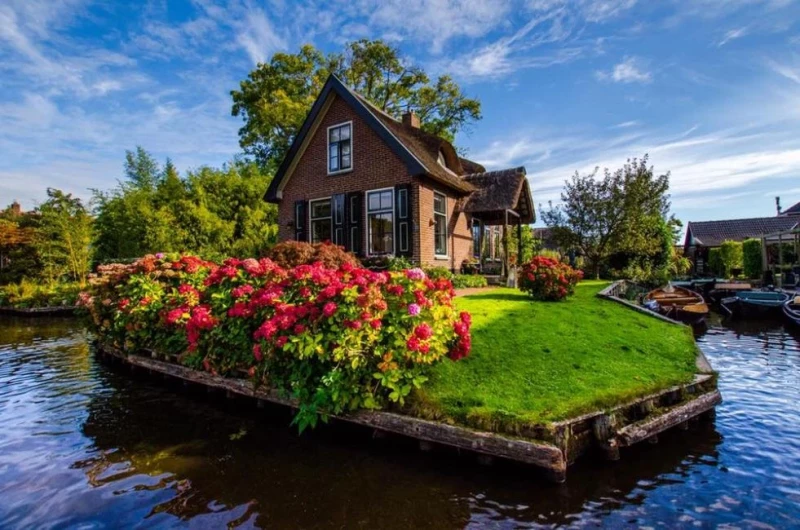
Giethoorn, often called the "Venice of the North," is a charming car-free village in the Netherlands, famous for its canals and thatched-roof houses. Boats are the main mode of transport, making it a tranquil and unique destination. Boat tours offer a serene way to explore the picturesque waterways. Walking and cycling paths provide alternative views of the village.
The traditional Dutch houses along the canals, adorned with thatched roofs, contribute to Giethoorn's idyllic atmosphere. Museums like the Museum Giethoorn 't Olde Maat Uus showcase the village's history and culture. Giethoorn is surrounded by lush gardens, and waterside restaurants offer delightful dining experiences.
Beyond its watery charm, Giethoorn is near De Wieden National Park, known for its diverse landscapes. The village occasionally hosts local events, adding to its cultural appeal. Giethoorn provides a peaceful retreat, inviting visitors to experience Dutch life amid canals, thatched roofs, and natural beauty.
 Our tips for getting the most out of your experience.
Our tips for getting the most out of your experience.
If you're planning a day trip to Giethoorn from Amsterdam, here are some tips to make your experience enjoyable:
-
Transportation: Opt for an organized tour that includes transportation from Amsterdam. This allows you to relax and enjoy the scenery during the journey.
-
Book in Advance: If choosing a guided tour, make sure to book in advance, especially during peak times. This ensures your spot and avoids disappointments.
-
Early Departure: Choose an early departure to maximize your time in Giethoorn and avoid crowds.
-
Boat Tour: Opt for a boat tour through Giethoorn's canals. It's one of the best ways to experience the charm of this car-free village.
-
Free Time: Ensure the excursion includes free time for you to explore the village at your own pace, perhaps by renting a small electric boat.
-
Waterside Dining: Enjoy lunch at one of the waterside restaurants for a picturesque culinary experience.
-
Comfortable Clothing: Wear comfortable clothing and walking shoes as Giethoorn has trails and bridges to explore.
-
Camera: Don't forget your camera to capture the beautiful landscapes, winding canals, and quaint houses.
-
Visit the Museum: Use your free time to visit the Museum Giethoorn 't Olde Maat Uus to learn more about the village's history.
-
Relax at De Wieden National Park: If weather permits, explore the surroundings by visiting De Wieden National Park, offering diverse natural landscapes.
-
Souvenir Shopping: End your day by souvenir shopping in local boutiques.
-
Check Return Times: Make sure you're aware of the excursion's return times to avoid unnecessary stress.
By following these tips, you'll be able to fully enjoy your day trip to Giethoorn from Amsterdam and have a memorable experience in this picturesque village.
Amsterdam - Where to Stay?
Amsterdam offers a variety of interesting neighborhoods to stay in, each with its own distinct charm. The choice of where to stay often depends on personal preferences, the type of experience you're looking for, and your interests. Here are some popular neighborhoods for staying in Amsterdam:
-
City Center (Centrum): This is the historic heart of Amsterdam, where you'll find Dam Square, the Red Light District, the Museum Quarter, and many major tourist attractions. It's ideal if you want to be in the thick of the action, but it can be more lively and bustling.
-
Jordaan: An artistic and trendy neighborhood, famous for its picturesque narrow streets, art galleries, independent shops, and charming cafes. It's a popular choice for those seeking a more laid-back atmosphere.
-
De Pijp: A bohemian and multicultural district known for its markets, international restaurants, and lively bars. It's also close to the Museum Quarter.
-
Leidseplein and Rembrandtplein: These central squares are surrounded by theaters, clubs, restaurants, and bars. It's an excellent choice if you're interested in Amsterdam's vibrant nightlife.
-
Oud-West: A burgeoning neighborhood with a youthful vibe, trendy boutiques, hip cafes, and restaurants. It offers an authentic local experience.
-
Oost (East): Up-and-coming, this area features trendy cafes, parks, and a more residential atmosphere. It provides a quieter experience while still being well-connected to the city center.
-
Amsterdam-Noord: Located across the IJ, this former industrial area has transformed into a creative hub with trendy restaurants, art galleries, and a panoramic view of the city from the A'DAM Tower observation deck.
Choose the neighborhood based on your preferences for ambiance, proximity to your favorite sites, and your budget. Most Amsterdam neighborhoods are well-connected by public transportation, and the city is relatively compact, making it easy to move from one area to another.
Amsterdam - How to get around?
Amsterdam provides several transportation options for getting around the city. Here are some popular choices:
-
Bicycles: Amsterdam is often referred to as the "City of Bikes." The city is highly bike-friendly, with numerous dedicated bike lanes. Renting a bike is easy and affordable, and it's one of the most popular and enjoyable ways for visitors to navigate the city.
-
Public Transportation: Amsterdam has a well-developed public transportation network, including trams, buses, metros, and ferries. You can use the OV-chipkaart to pay for your public transportation journeys. Trams are particularly convenient for quick travel within the city center.
-
Boats: The canals of Amsterdam are traversed by many canal cruise boats and water taxis. It's a picturesque way to experience the city from the water.
-
Walking: Amsterdam is a relatively compact city, and many attractions are within walking distance of each other, especially in the city center. Walking is an excellent way to explore the charming streets, canals, and lively neighborhoods.
-
Car: While driving may not be recommended in the city center due to dense traffic and limited parking, renting a car can be useful if you plan to visit locations outside the city.
-
Taxi: Taxis are available in Amsterdam, but they are generally more expensive than other modes of transportation. Taxi stands can be found at key locations in the city, such as train stations and main squares.
In summary, biking and public transportation are typically the most convenient and efficient options for getting around Amsterdam, providing visitors with an authentic experience of the city.
Amsterdam - Best period
The best time to visit Amsterdam depends on personal preferences and the activities you wish to do. Here are some considerations for each season:
-
Spring (March to May): Spring is a popular time to visit Amsterdam. Temperatures start to warm up, tulips bloom in gardens, and days lengthen. It's also the festival season, and the cafe terraces along the canals start to come alive.
-
Summer (June to August): Summer in Amsterdam is pleasant with long, sunny days. It's the peak tourist season, and the city is bustling with outdoor events, festivals, and activities. Parks are green, and the canals are particularly charming.
-
Autumn (September to November): Autumn is a quieter period after the busy summer season. Temperatures remain mild, and the leaves start to change color. It's a good time to enjoy the city with fewer crowds.
-
Winter (December to February): Winter in Amsterdam can be cold, but the city takes on a magical atmosphere with Christmas lights and markets. The canals may freeze, offering picturesque winter scenes. It's also a time to enjoy museums and cozy indoor spaces.
Each season has its own charms, so the choice of the time to visit depends on your preferences for weather conditions and activities. Keep in mind that July and August are the busiest months, while winter may be quieter in terms of tourism. Regardless of the season, Amsterdam has something to offer throughout the year.
